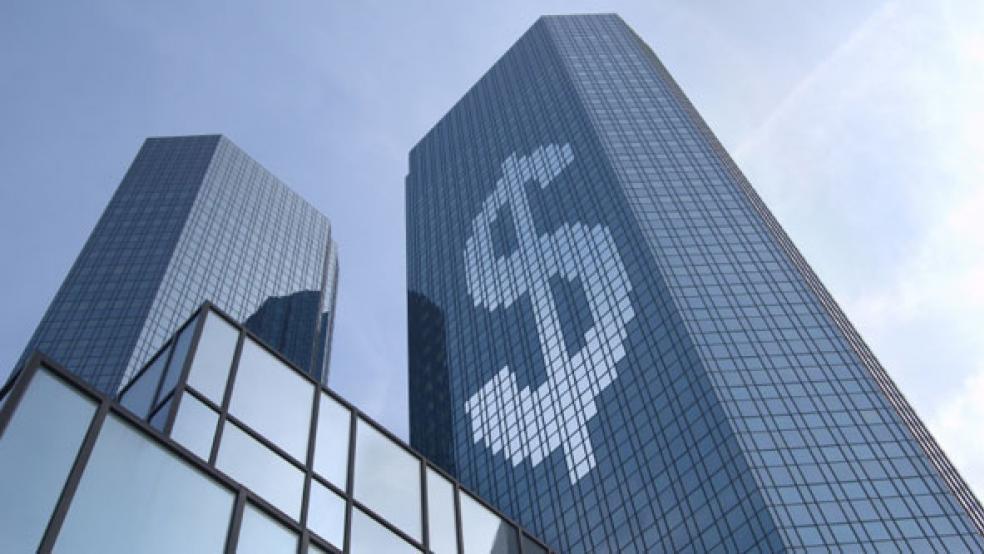HBO announced last week that it will release Too Big to Fail on May 23rd, a film based on Andrew Ross Sorkin’s book. Viewers will judge the film partly on how well it captures the desperation of late 2008 as Paulson, Bernanke, Geithner and others sought to avoid complete financial meltdown. But what we really ought to worry about is whether the film will be a forecast of the future.
You might assume that any lawmakers who can read a poll would make absolutely sure that taxpayers would not have to bail out the world’s richest banks ever again. That was, after all, an explicit goal of the Dodd-Frank financial reform act, and Hank Paulson’s successor, Timothy Geithner (playing himself in Congressional testimony), promised that Dodd-Frank’s “reforms will end ‘too big to fail.’”
Actually, rather than ending “too big to fail,” the law enshrines it. As economists ranging from the conservative Dallas Fed President Richard Fisher to MIT’s liberal Simon Johnson have pointed out, Dodd-Frank’s structure makes TBTF the law of the land. Legislators left much of Dodd-Frank’s detail work to the SEC, FDIC and others, but judging from the rules proposed so far, the regulators, intentionally or otherwise, will further concentrate power in the hands of the too-big.
come to mean “protected by Uncle Sam.”
During the crisis it was clear that some institutions — AIG, Citibank and Goldman Sachs come to mind — were so interconnected that their failure could have collapsed the global financial system. Having failed to keep them solvent, regulators had no choice but to bail them out. But that doesn’t mean a taxpayer rescue of big, intertwined institutions is the only possible course from now on. Indeed the most obvious way to prevent a repeat is to break such behemoths into smaller, less dangerous entities. That’s what post-Great Depression reforms did. As economist Joseph Stiglitz put it: “If an institution is too big to fail, it’s too big.”
Instead of breaking up banks, Dodd-Frank separates banks with more than US$50 billion in assets and certain other large financial institutions into a class of “systemically important” entities — too big to fail by another name. The special status makes sense, as far as it goes. Once identified, “systemically important” companies have to submit to tougher scrutiny and stiffer capital requirements, both of which will make them safer, all else being equal.
Of course, all else is never equal. Inevitably, “systemically important” will come to mean “protected by Uncle Sam.” Banks enjoying the Fed’s implied backing have a huge competitive advantage over smaller rivals. Since creditors know Uncle Sam will bail them out, they’ll be able to borrow at lower rates than their smaller competitors — insuring that they will only get bigger, more systemically important, and hence riskier. (According to Johnson, big banks already can borrow for about three-quarters of a percentage point less than smaller competitors.) That would track the not exactly encouraging history of Fannie Mae and Freddie Mac:
debate from the beginning, since it submitted the
original draft in 2009 that became the basis for the law.
Under the implicit federal umbrella, the two lent and borrowed so recklessly that when the crisis hit, they had to be nationalized at an ultimate cost to taxpayers estimated at $73 billion. True, the law gives regulators broad powers to rein in banks that take too much risk, but the whole edifice depends on regulators doing what they failed to do before the crisis: To understand the risks that horrifically complex global financial institutions are taking (and may be doing their utmost to hide), to anticipate the onset of a crisis, to coordinate responses with regulators in other countries, and to avoid being won over by the firms they regulate.
Why did lawmakers do it this way? Johnson, Stiglitz, Wallison (also an economist) and their allies certainly didn’t keep their views to themselves. “I would have preferred that the law break up large financial institutions,” Dallas Fed President Richard Fisher told a group of business editors last week. “But I lost that battle.” Richard Skeel, a Wharton School professor and author of The New Financial Deal, a book about Dodd-Frank, explains that the Treasury Department controlled the debate from the beginning, since it submitted the original draft in 2009 that became the basis for the law. That draft, by the way, was written in close consultation with Davis Polk, a corporate law firm that represents many large banks and the financial industry’s lobbying group; thanks to a computer glitch, the original draft still bore the Davis Polk watermark when the Treasury Department submitted it to Congress.
What’s wrong with having banking regulators draft Dodd-Frank? They’re the experts after all. Skeel explains by contrasting the drafting of Dodd Frank with the behavior of a bank faced with a soured commercial loan:
If the borrower falls into financial distress, the loan is transferred to a different department, the workout group. Banks don’t let the original loan officer handle the negotiations to restructure the loan because they suspect that the loan officer’s judgment may be colored by the rationales that caused him or her to make the loan in the first place. Banks know, and have known for generations, that they need a fresh set of eyes after things go wrong. Dodd-Frank ignored this basic principle of sound business….Geithner’s Treasury Department devised a framework that attempts to perfect what he, [then Treasury Secretary] Hank Paulson and Bernanke did in 2008. By implication the new law legitimizes their bailouts and covers their tracks.
It is, of course, possible that regulators will use their new Dodd-Frank powers with perfect wisdom, foresight, global coordination and restraint. It’s also possible that “systemically important” financial institutions won’t exploit the competitive advantage handed to them under the new law. But so far the opposite has happened: the largest banks control more of the market than they did before the crisis as they’ve absorbed smaller banks.
Wallison foresees Dodd-Frank creating scores of Fannies and Freddies, a prospect that fills him with something other than delight. “The identification of firms as too big to fail is a mad policy,” he wrote in a Wall Street Journal opinion piece. “We’ve seen this movie before.” And he’s not talking about HBO.
Related Links:
Simon Johnson Explains "What the Banks Did To Us" And Why "Seriously — Goldman Sachs Can't Fail" (Business Insider)
Banks Too Big to Fail Could Get Bigger (Bloomberg Business Week)
Too Big to Fail (The Economist)






